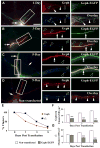Gephyrin clustering is required for the stability of GABAergic synapses
- PMID: 17916433
- PMCID: PMC2464357
- DOI: 10.1016/j.mcn.2007.08.008
Gephyrin clustering is required for the stability of GABAergic synapses
Abstract
Although gephyrin is an important postsynaptic scaffolding protein at GABAergic synapses, the role of gephyrin for GABAergic synapse formation and/or maintenance is still under debate. We report here that knocking down gephyrin expression with small hairpin RNAs (shRNAs) in cultured hippocampal pyramidal cells decreased both the number of gephyrin and GABA(A) receptor clusters. Similar results were obtained by disrupting the clustering of endogenous gephyrin by overexpressing a gephyrin-EGFP fusion protein that formed aggregates with the endogenous gephyrin. Disrupting postsynaptic gephyrin clusters also had transsynaptic effects leading to a significant reduction of GABAergic presynaptic boutons contacting the transfected pyramidal cells. Consistent with the morphological decrease of GABAergic synapses, electrophysiological analysis revealed a significant reduction in both the amplitude and frequency of the spontaneous inhibitory postsynaptic currents (sIPSCs). However, no change in the whole-cell GABA currents was detected, suggesting a selective effect of gephyrin on GABA(A) receptor clustering at postsynaptic sites. It is concluded that gephyrin plays a critical role for the stability of GABAergic synapses.
Figures








Similar articles
-
Differential regulation of the postsynaptic clustering of γ-aminobutyric acid type A (GABAA) receptors by collybistin isoforms.J Biol Chem. 2011 Jun 24;286(25):22456-68. doi: 10.1074/jbc.M111.236190. Epub 2011 May 3. J Biol Chem. 2011. PMID: 21540179 Free PMC article.
-
Disruption of postsynaptic GABA receptor clusters leads to decreased GABAergic innervation of pyramidal neurons.J Neurochem. 2005 Nov;95(3):756-70. doi: 10.1111/j.1471-4159.2005.03426.x. J Neurochem. 2005. PMID: 16248887
-
alpha5 Subunit-containing GABA(A) receptors form clusters at GABAergic synapses in hippocampal cultures.Neuroreport. 2002 Dec 3;13(17):2355-8. doi: 10.1097/00001756-200212030-00037. Neuroreport. 2002. PMID: 12488826
-
Synaptic and extrasynaptic GABAA receptor and gephyrin clusters.Prog Brain Res. 2002;136:157-80. doi: 10.1016/s0079-6123(02)36015-1. Prog Brain Res. 2002. PMID: 12143379 Review. No abstract available.
-
Gephyrin: where do we stand, where do we go?Trends Neurosci. 2008 May;31(5):257-64. doi: 10.1016/j.tins.2008.02.006. Epub 2008 Apr 9. Trends Neurosci. 2008. PMID: 18403029 Review.
Cited by
-
Gender-specific effect of Mthfr genotype and neonatal vigabatrin interaction on synaptic proteins in mouse cortex.Neuropsychopharmacology. 2011 Jul;36(8):1714-28. doi: 10.1038/npp.2011.52. Epub 2011 Apr 13. Neuropsychopharmacology. 2011. PMID: 21490592 Free PMC article.
-
Early postnatal switch in GABAA receptor α-subunits in the reticular thalamic nucleus.J Neurophysiol. 2016 Mar;115(3):1183-95. doi: 10.1152/jn.00905.2015. Epub 2015 Dec 2. J Neurophysiol. 2016. PMID: 26631150 Free PMC article.
-
Recruitment of Plasma Membrane GABA-A Receptors by Submembranous Gephyrin/Collybistin Clusters.Cell Mol Neurobiol. 2022 Jul;42(5):1585-1604. doi: 10.1007/s10571-021-01050-1. Epub 2021 Feb 5. Cell Mol Neurobiol. 2022. PMID: 33547626 Free PMC article.
-
PSD-95 deficiency alters GABAergic inhibition in the prefrontal cortex.Neuropharmacology. 2020 Nov 15;179:108277. doi: 10.1016/j.neuropharm.2020.108277. Epub 2020 Aug 18. Neuropharmacology. 2020. PMID: 32818520 Free PMC article.
-
Duplicated gephyrin genes showing distinct tissue distribution and alternative splicing patterns mediate molybdenum cofactor biosynthesis, glycine receptor clustering, and escape behavior in zebrafish.J Biol Chem. 2011 Jan 7;286(1):806-17. doi: 10.1074/jbc.M110.125500. Epub 2010 Sep 14. J Biol Chem. 2011. PMID: 20843816 Free PMC article.
References
-
- Boucard AA, Chubykin AA, Comoletti D, Taylor P, Sudhof TC. A splice code for trans-synaptic cell adhesion mediated by binding of neuroligin 1 to alpha- and beta-neurexins. Neuron. 2005;48:229–236. - PubMed
-
- Bruckner K, Pablo Labrador J, Scheiffele P, Herb A, Seeburg PH, Klein R. EphrinB ligands recruit GRIP family PDZ adaptor proteins into raft membrane microdomains. Neuron. 1999;22:511–524. - PubMed
Publication types
MeSH terms
Substances
Grants and funding
LinkOut - more resources
Full Text Sources
Research Materials

